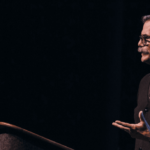
Anthropology, Hamartiology and Biblical Critical Theory
Thankfully, good and evil are not co-equal:
Let me unpack my title for you: people and sin are the topics I examine here and I once again refer to an important new book that I have been looking at in this irregular series: Christopher Watkin’s volume Biblical Critical Theory. In this third article on the book, I look at what he says about the doctrine of man and the doctrine of sin.
Ch 6 is titled “Sin, Anthropology, and Asymmetry.” He argues that many worldviews seek to understand mankind from the present only. But the biblical worldview insists that we must go back in history to really see who we are and why we exist. And all that is found in the first three chapters of Genesis.
Chapters 1 and 2 of course provide us with the creation account where we learn that we are made in the very image of God. But chapter 3 informs us that sin entered the world and greatly distorted that image and has radically impacted upon what people were meant to be. Such an understanding makes all the difference in the world.
As he states: “Put at its simplest, it means that not everything that exists in the present ought to be as it now is: not every desire is good, not every possession is legitimate, not every hope is wholesome. We cannot underestimate the complexity and nuance that this brings to a Christian analysis of people and society.” 159
And again: “Human beings created in the image of God have a wonderfully stubborn capacity for godlike actions of love, compassion, and generosity. Human beings who have chosen the way of autonomy have an ever-renewed capacity for unreason and brutal violence.” Thus we have “breathtaking acts of kindness” along with “stomach-churning deeds of barbarity.” 162


Nonetheless there is a very real asymmetry of good and evil. Following common theological thought, Watkin stresses that the biblical view is different from any form of dualism, where good and evil are seen as co-equal and co-eternal. Goodness will always be with us, being part of who God is.
Evil however is an intruder. Evil is parasitical of the good as Augustine and others have argued. We find the differences early on in Genesis. Says Watkin:
First, there is a temporal difference: creation and fall are not simultaneous in the biblical account. The “it was very good” of Genesis 1 precedes the “cursed is the ground” of Genesis 3. Second, there is an ontological difference: God and the serpent are not two cooriginal, equal, and opposite deities but the serpent is one of God’s creatures (3:1) and bound by his curse (3:14-15). Thirdly, there is an asymmetry of blessing and sin for Adam and Eve. God did not say “let us make sinners,” but “let us make man in our image” (1:26). The curse does not nullify the blessing of the creation mandate; it qualifies it. Sin does not ultimately define Adam and Eve, and it does not ultimately define you and me either, praise the Lord! Sin is an ingrained and inveterate part of who we are in the present, but it is neither a foundational nor a final aspect of our identity. So both good and evil are present after Genesis 3, but they are present asymmetrically. Evil is not original, nor will it linger forever. 167
He continues:
So in the same way that the doctrine of the image of God both exalts humanity (because human beings alone are in the image of God) and humbles humanity (because we are not gods, but rather the image of God), so also Genesis 3 shows both the limits and the all-pervasive consequences of sin and evil. Genesis 3 tells us that evil is real and serious, a sentiment with which the pessimist nods along in agreement. It also tells us that evil is not ultimate and not intrinsic to the nature of the world, a proposition of which the utopian enthusiastically signals her approval. For those who deny a temporal fall, however, and if it is admitted that the world we live in is not perfect, then evil has to be an eternal, or at least an intrinsic element of the natural world, just as original as the good. So an important function of the fall in the biblical narrative is in fact, and perhaps a little surprisingly, to limit evil, to say that it is not original, that it has a beginning in history, and that it is not a feature of humanity as originally created, however inveterate and inescapable it is now. The biblical account of sin is not, as society would portray it, crushing, cruel, and counterproductive, but it limits evil, leads to democracy and equality, and legitimates hope and radical transformation. 168
We see how this understanding informs our way of doing cultural critique. The world that we live in, and all that is part of it (society, culture, the arts, and all forms of human activity) are neither as bad as they can possibly be nor as good as they can possibly be. In a fallen world nothing is perfect in this life.
As such, the Christian “should be neither gullible nor cynical.” We can enjoy the good things God has blessed us with in this world, but never should we enjoy them so much and so exclusively that they become an idol. The doctrine of common grace that Kuyper and others have made so much of certainly comes into play here.
Everything that God created was good, but everything in this world is now impacted by sin. So we neither worship this world nor fully reject this world. Says Watkin: “At every point, then, evil is asymmetrically overwriting but not destroying a more primordial and enduring message of blessing and love; at every point it is temporally bounded, framed, and relativized by an original good creation.” 169
He goes on to explain this in more detail:
This means that a biblical attitude to this world can neither be one of simple affirmation nor of straightforward condemnation. Wherever Christians look in the cultural world, they will find Hart’s palimpsests: no social movement, no artefact, no text, no church, no performance, and no academic discipline is free from the violence, selfishness, delusion, and rebellion of sin, however “Christian” they might appear, and similarly nothing in culture is so full of these things that it can fully erase the goodness of the original creation. This is one of the reasons why, as Timothy Keller points out, a Christian approach to social critique is a particularly open and sophisticated form of cultural engagement: for the Christian nothing in culture is utterly evil, and nothing is exhaustively good: cultural criticism, just as much as anthropology, is multi-lens.
This does not mean that all Christians have to be open to reading everything, watching everything, and listening to everything; as Paul wisely notes, “Everything is permissible for me, but not everything is beneficial” (1 Cor 6:12). Nevertheless, there is a profound difference between a Christian cultural asceticism and its non-Christian namesake. 169
He then quotes from an essay by C. S. Lewis in this regard:
Because God created the Natural – invented it out of His love and artistry – it demands our reverence; because it is only a creature and not He, it is, from another point of view, of little account. And still more, because Nature, and especially human nature, is fallen, it must be corrected and the evil within it must be mortified. But its essence is good; correction is something quite different from Manichaean repudiation or Stoic superiority. Hence, in all true Christian asceticism, that respect for the thing rejected which, I think, we never find in pagan asceticism. Marriage is good, though not for me; wine is good, though I must not drink it; feasts are good, though today we fast. (God in the Dock, 148-149)
Watkin applies this further in areas such as politics. He concludes his chapter with these words:
So even in the very midst of the curses of Genesis 3, it is clear that sin will not be the final word in the Bible’s story. Sin is not original. The theological notion of “original sin” means that all human beings after Adam inherit his sin and its consequences, that “in Adam all die” (1 Cor 15:22); it does not mean that sin is there at the beginning of creation. At the end of this dark chapter we hold onto the hope that its curse will not be the final word. Yet from this point on until the very end of the Bible’s story we find that sin and obedience, judgement and grace, the ethic of violence and the ethic of love, the city of God and the earthly city, will be inextricably intertwined. 177
Stay tuned for further articles looking at other chapters from this important volume.
[1479 words]




















After your review from a few weeks ago I felt I had to get that book.
Now it’s in my possession – up here in the north…
THANKS BILL
Thanks Rolf.
Hi Bill,
We are all atheists at birth, and mainly become theists because of the culture of our place of birth and parental indoctrination. It always strikes me as odd that, if there is a God, he only spread his message in the West.
Thanks Virginia. It would be much more accurate to claim: ‘We are all theists at birth (being made in God’s image), and mainly become atheists because of the culture of our place of birth and parental indoctrination. It always strikes me as odd that, if there is no God, atheists only spread their message in the West.’
And to further call your bluff, if you knew anything about the spread of Christianity, you would realise that it began in the non-West (the Middle East); spread further, helping create what we now refer to as the West; and now it is especially spreading in the non-West (Africa, Asia and Latin America).